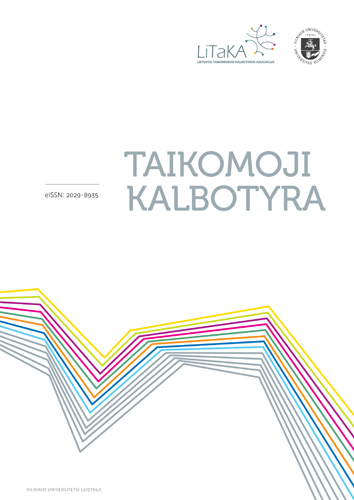I„Radijuj ir televizijoj gal net vilnietiškai jie kalba“. Sakytinės žiniasklaidos ir Vilniaus kalbos nekirčiuotų kintamųjų /i:/, /u:/, /e:/, /o:/, /æ:/ ir /a:/ akustinė analizė
“On the radio and TV perhaps they even speak Vilnius-like”. An acoustic analysis of unstressed variables /i:/, /u:/, /e:/, /o:/, /æ:/ and /a:/ in broadcast media and Vilnius speech
Author(s): Ramunė ČičirkaitėSubject(s): Sociolinguistics, Theory of Communication
Published by: Vilniaus Universiteto Leidykla
Keywords: variants of unstressed variables; instrumental measurement of quantitative and qualitative features; spontaneous speech; spoken media; Vilnius speech; sociolinguistics;
Summary/Abstract: The article focuses on the speaker evaluation experiment conducted in the spring of 2016 in Vilnius schools with Russian as the language of instruction. The aim of the experiment was to reveal the students’ subconscious attitudes (evaluations) and determine whether the four speaking styles of Vilnius, which had been distinguished conventionally for the purposes of the research, were recognized by the respondents and what social meanings the styles were associated with. The same experiment was conducted in 2014 in Vilnius schools with Lithuanian as the language of instruction. The study proved the hypothesis that there was a clear hierarchy of the speech styles differentiated by the variants of /i/, /u/, /i + R/, /u + R/ of different duration used in a stressed position. The styles are socially significant to ethnic Lithuanian school students and function as markers of social personality types associated with different personality traits, professions and ethnicity. This year’s experiment is based on the assumption that the social stigma created by standardization ideology and associated with Slavic speakers has affected the subconscious attitudes of students from Russian schools so much that Vilnius speech styles will evoke to them similar associations to those of the students of Lithuanian origin; in other words, phonetic variants which distinguish the styles are likely to identify the same social types of speakers.The research has proved the initial hypothesis. The style Kam+GalSL used by Vilnius city dwellers of Slavic origin tends to be perceived as revealing a Slavic background but does not serve as a marker of high social status and high professional competence. Therefore, even though the participants of the experiment attend Russian schools, their linguistic attitudes are not lingo-centric, namely, they are involved in the same field of social meanings as the Lithuanian school students (such social meanings as non-Lithuanian, less educated, having a poorer job are chosen when reflecting on the Slavic pronunciation). Therefore, the respondents may apply the same ideological scheme on the subconscious level while evaluating the speech of a group to which they belong according to the distinguished features of stimuli. Additional social meanings of this style include otherness (weird), poor communicational skills (poor speaker), low social status and working-class professions indicating meanings (laborer, janitor, market dealer).It seems that the variability of duration in stressed /i/, /u/, /i + R/, /u + R/, which is typical of Lithuanian city dwellers in Vilnius, acquires a different value among Russians speakers in Vilnius. The Kam speaking style, originating from a dialect and distinguished by phonetic variants, is associated with a lower social value in comparison with the styles Kam+GalLT and Neu, which include strongly stigmatized phonetic variants, associated with the speech of Vilnius city dwellers. Both styles Kam+GalLT and Neu are associated with a social type of a speaker of high social status, substantial income, leading positions and high professional competence; however, their sub-types of association are different. Representatives of the Kam speaking style are characterized as provincial, of lower status, working-class professions and representatives of the services area.The paper focuses on the quantitative and qualitative features of variants of unstressed variables /i:/, /u:/, /e:/, /o:/, /æ:/ and /a:/ in spontaneous broadcast media as compared with spontaneous Vilnius speech. The research also explores how the variants of the variables are located on the spectrum, whether the speaker’s type (his linguistic education) has any impact on the length and tenseness of the variants. The research was conducted using for acoustic analysis the sound analysis program PRAAT. The informants were six Vilnius city dwellers and six radio and TV hosts. The data of the Vilnius city dwellers’ speech drew on targeted sampling from the database “Vilnius speaking”. The hosts were chosen from a representative Corpus of Broadcast Media. The empirical data consists of 840 variants of unstressed variables /i:/, /u:/, /e:/, /o:/, /æ:/ and /a:/, equally selected from each speaker’s spontaneous speech.The survey has revealed that the quantitative and qualitative features of the variants of unstressed variables /i:/, /u:/, /e:/, /o:/, /æ:/ and /a:/ used in the hostsʼ spontaneous speech are very similar to those used by spontaneously speaking Vilnius city dwellers. This leads to a conclusion that Vilnius speech is more firmly entrenched in the prestigious public discourse (broadcast media) than the codified standard language. In our speech community Vilnius speech may function as a model of exemplary pronunciation, thus strengthening the role of Vilnius speech in public discourse and at the same time weakening the positions of standardisation ideology. The investigation has confirmed that phonetic features traditionally assigned to Vilnius speech are erroneously associated only with private discourse and speakers of low social status; however, these features inevitably gain their highest value when used in broadcast media.
Journal: Taikomoji kalbotyra
- Issue Year: 2016
- Issue No: 8
- Page Range: 107-135
- Page Count: 29
- Language: Lithuanian

